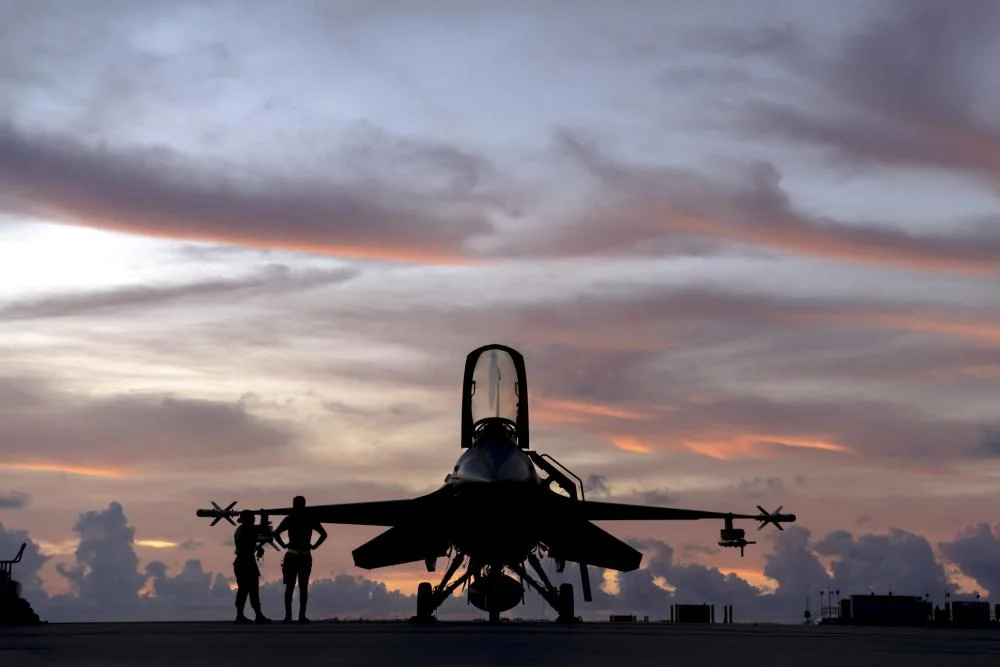DVIDS – News – 180FW Trains with the “Sun Downers” in the Sunshine State
150 Airmen and 10 F-16 Fighting Falcons from the Ohio National Guard’s 180th Fighter Wing deployed to Naval Air Station Key West, Fla., to train with the Navy’s Fighter Squadron Component (VFC) 111 in late October, 2022.
Key West, Florida is a popular vacation spot. With consistently great weather and vast ocean space, it’s a great spot to relax. Those same things that draw in tourists also make it a great place for military aviation.
“Besides just being in a sunny place in November, the airspace out here is unlike the airspace we have back home,” said U.S. Air Force Maj. Jake Laginess, 180FW F-16 fighter pilot and project officer for the training. “It’s a lot closer to where we’re operating out of, it’s a lot bigger and there’s fewer restrictions, so it allows us to fly closer to how we would in combat.”
While at Key West, the 180FW made the most out of their training by accomplishing two different training objectives simultaneously.
“We’re working with another F-16 unit, out of Homestead Air Force Base, and we’re also flying with dissimilar F-5s,” said Laginess.
The F-5N Tiger IIs that the 180FW trained with are part of the Navy’s VFC-111, which provides quality adversary training to Navy and Air Force units.
“VFC-111 is an adversary squadron,” said U.S. Navy Cmdr. Lee Smallwood, a member of VC-111s leadership, “so we simulate the bad guys day in and day out.”
According to Smallwood, the VFC-111 assesses current adversary tactics, then replicates them for U.S. fighter pilots to exercise com bat maneuvers against.
“One distinctive advantage we have is that we are pretty well-versed in what the good guy tactics and capabilities are,” said Smallwood, “so if they want us to be as difficult as possible, we can tailor our presentations to try to make it as difficult as possible for the good guys, since we know what they’re going to do, and we can build our reactions to preempt some of those.”
According to U.S. Navy Cmdr. Matt Gibson, another member of the VFC-111 leadership team, the F-5 pilots can even replicate maneuvers and tactics of different types of aircraft, giving other fighter pilots the chance to practice facing adversary aircraft before ever actually encountering one in a real-world situation.
“The F-5s are not as capable of an aircraft as the F-16,” said Laginess, “but those guys are really good at what they do, as far as being adversaries. They’ve really learned what the threat out there does and what they’re like, so they’re good at it.”
Facing these experienced fighter pilots isn’t the only challenging thing about going up against the VFC-111. According to Laginess, who’s also a former U.S. Navy pilot, one of the biggest challenges lies in the differences between the services.
“The biggest challenge is actually going back to fly with a Navy unit,” said Laginess. “When we’re flying with them, we just speak different languages. We do the same job, we’re just using different words to get there. So, the challenge is trying to translate between the two and figure out what each of us means.”
“Training with the VFC-111 provides exposure to operating with the Navy,” said Laginess. “If we were ever to have a big war with a near peer, we’re going to have Navy and other assets out there, so it’s nice to get out of our bubble and learn to interact and integrate with other units.”
Despite the cross-service language barrier, the 180FW was still able to accomplish its mission.
“They are absolutely professional in the air and on the ground,” said Gibson, when asked about working with the 180FW pilots, “absolutely professional.”
It takes more than pilots to ensure the 180FW can accomplish its mission. A pilot’s main concern is flying their aircraft, so having fully mission-capable aircraft is essential.
“From a maintenance perspective, our goal here is to provide combat-ready aircraft for the training that the pilots need to be doing up there,” said Maj. Jason Logsdon, 180FW maintenance officer in charge of the maintenance portion of training. “It doesn’t matter how much you prepare and plan, there’ll always be some hiccups that happen, and we just work through those. We’re flying great. Other than the humidity, the weather’s been pretty awesome. The pilots are having great training out there.
Through the combined efforts of the pilots in the air and the Airmen on the ground, the 180FW was able to fly 118 sorties, totaling 145.5 flying hours, enhancing mission capabilities of aircrew, ground and support personnel.
| Date Taken: | 11.14.2022 |
| Date Posted: | 11.14.2022 10:18 |
| Story ID: | 433199 |
| Location: | NAVAL AIR STATION KEY WEST, FL, US |
| Web Views: | 4 |
| Downloads: | 1 |
PUBLIC DOMAIN
This work, 180FW Trains with the “Sun Downers” in the Sunshine State, by SSgt Kregg York, identified by DVIDS, must comply with the restrictions shown on https://www.dvidshub.net/about/copyright.


 Private Internet Access gives you unparalleled access to thousands
of next-gen servers in over 83 countries and each US state. Your
VPN experience will always be fast, smooth, and reliable.
Private Internet Access gives you unparalleled access to thousands
of next-gen servers in over 83 countries and each US state. Your
VPN experience will always be fast, smooth, and reliable.
